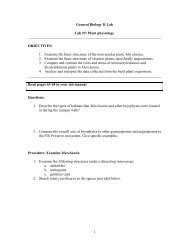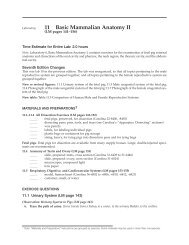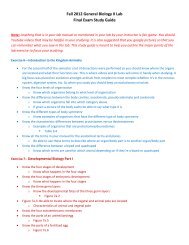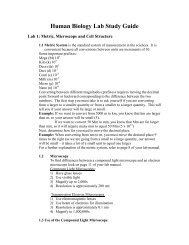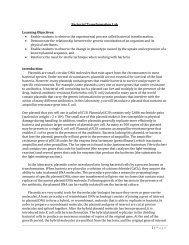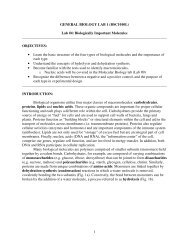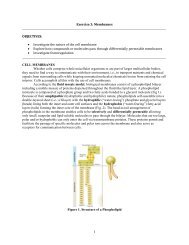1 GENERAL BIOLOGY LAB 1 (BSC1010L) Lab #10: Biotechnology ...
1 GENERAL BIOLOGY LAB 1 (BSC1010L) Lab #10: Biotechnology ...
1 GENERAL BIOLOGY LAB 1 (BSC1010L) Lab #10: Biotechnology ...
- No tags were found...
You also want an ePaper? Increase the reach of your titles
YUMPU automatically turns print PDFs into web optimized ePapers that Google loves.
Develop a Hypothesis:Based on your expectations (Table 1), state null and alternative hypotheses regarding what youexpect to see if the bacteria plated on an ampicillin rich medium were successfully transformed.Procedure:1. Obtain two sterile Eppendorf tubes.a. Mark one tube “+ DNA” – this tube will receive the plasmid.b. Mark the other “- DNA”.2. On the side of both tubes, write your group number.3. Add 250µL of ice-cold calcium chloride (CaCl 2 ) to each tube using a sterile transferpipette. Addition of CaCl 2 to the host cells, followed by heat shock (see step 14),increases the likelihood of plasmid uptake. Cells that are able to take up the plasmidDNA are referred to as competent cells.4. Place both tubes on ice.5. Using one side of a plastic sterile loop, transfer a cell mass of E. coli cells from the starterplate into the + DNA tube by sweeping the cells superficially.a. Note: You only need a small quantity of bacteria. Do NOT completely fill theloop.Notes:• Be careful not to transfer any agar from the plate along with the cell mass• Immerse the cells on the loop in the calcium chloride solution in the + DNA tubeand vigorously tap the loop against the wall of the tube to dislodge the cell mass.Hold the tube up to the light to observe that the cell mass has fallen off the loop.6. Immediately suspend the cells by repeatedly pipetting in and out with a sterile transferpipette. Be careful not to spill the contents.• Examine the tube against the light to confirm that no visible clumps of cellsremain in the tube or are lost in the bulb of the transfer pipette. The + DNAtube should be appear cloudy while the - DNA tube should be clear (Fig. 1).4



